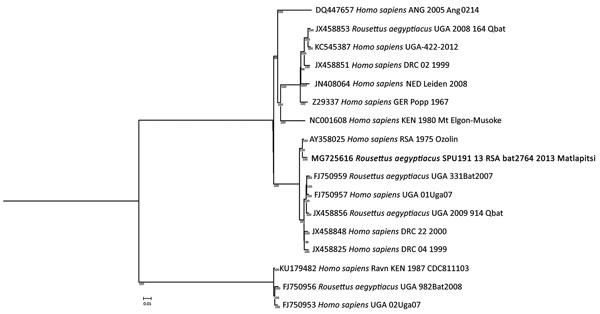Volume 24, Number 6—June 2018
Dispatch
Marburg Virus Infection in Egyptian Rousette Bats, South Africa, 2013–20141
Figure 2

Figure 2. Phylogenetic tree of partial (97.5%) Marburg virus nucleic acid sequence detected in Egyptian rousette bats in Matlapitsi Cave, Limpopo Province, South Africa, 2013 (bold; GenBank accession no. MG725616) and complete nucleic acid sequences of representative Marburg virus strains from GenBank. Node values indicate posterior probability percentages obtained from 1,000,000 generations in MrBayes version 3.2.6 (http://mrbayes.sourceforge.net/download.php). Scale bar indicates nucleotide substitutions per site.
1Some preliminary results from this study were presented at the 6th International Symposium on Filoviruses; March 30–April 2, 2014; Galveston, Texas, USA.
Page created: May 17, 2018
Page updated: May 17, 2018
Page reviewed: May 17, 2018
The conclusions, findings, and opinions expressed by authors contributing to this journal do not necessarily reflect the official position of the U.S. Department of Health and Human Services, the Public Health Service, the Centers for Disease Control and Prevention, or the authors' affiliated institutions. Use of trade names is for identification only and does not imply endorsement by any of the groups named above.